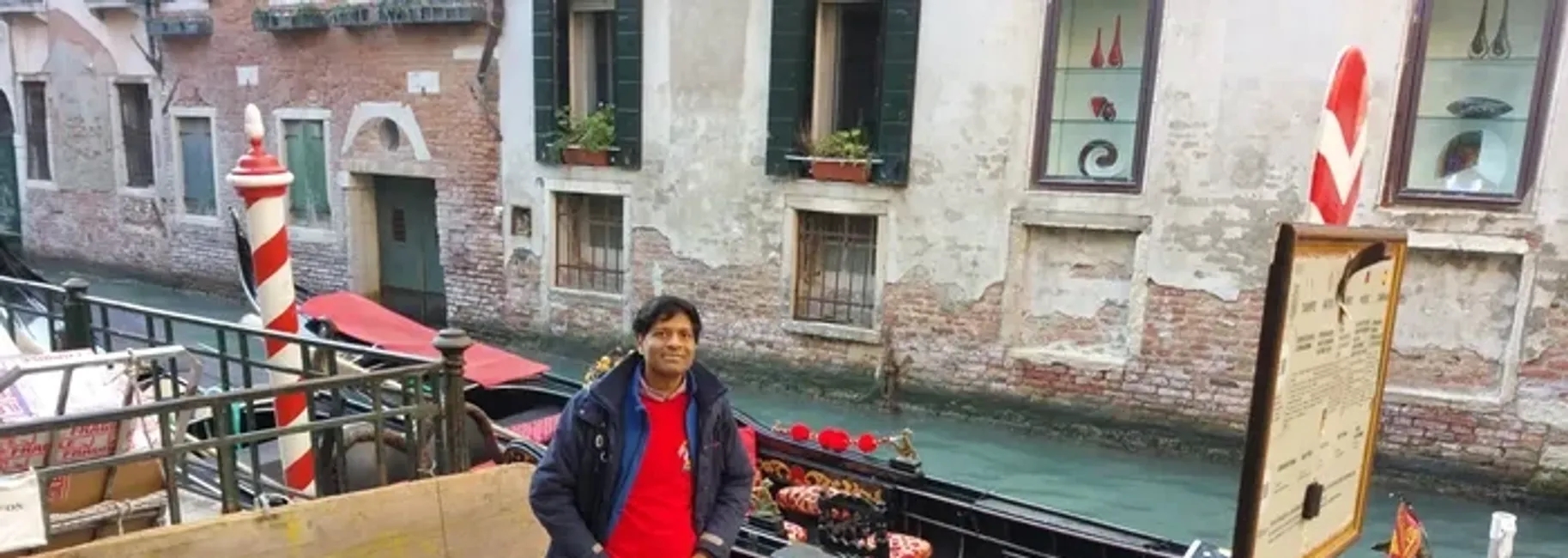
The gondola is a traditional, flat-bottomed Venetian rowing boat, well suited to the conditions of the Venetian lagoon. It is similar to a canoe. It is propelled by a gondolier, who uses a rowing oar, which is not fastened to the hull, in a sculling manner and acts as the rudder. For centuries, the gondola was a major means of transportation and the most common watercraft within Venice
- In modern times, the boats still do have a role in public transport in the city, serving as traghetti (small ferries) over the Grand Canal operated by two oarsmen
- For some years there were seven traghetti but by 2017, the number had been reduced to three
- Various types of gondola boats are also used in special regattas (rowing races) held amongst gondoliers. Their primary role today, however, is to carry tourists on rides at fixed rates.
- There are approximately 400 licensed gondoliers in Venice and a similar number of boats, down from the thousands that travelled the canals centuries ago
- However, they are now elegant craft, instead of the various types of shabby homemade boats of the distant past
Describe the history and usage of Gondola
- The gondola has existed in Venice since the 11th century
- It is estimated that there were eight to ten thousand gondolas during the 17th and 18th century, but there are only around four hundred in active service today, with virtually all of them used for hire by tourists
- Those few that are in private ownership are either hired out to Venetians for weddings or used for racing
- Even though the gondola, by now, has become a widely publicized icon of Venice, in the times of the Republic of Venice it was by far not the only means of transportation
- On the map of Venice created by Jacopo de’ Barbari in 1500, only a fraction of the boats are gondolas, the majority of boats are batellas, caorlinas, galleys, and other boats
- Now, only a handful of batellas survive, and caorlinas are used for racing only
How is a Gondola propelled ?
- The gondola is propelled by a person (the gondolier) who stands on the stern facing the bow and rows with a forward stroke, followed by a compensating backward stroke
- The oar rests in an elaborately carved wooden rest (forcola) shaped to project from the side of the craft so as to allow the slight drag of each return stroke to pull the bow back to its forward course
- Because of the vessel’s flat bottom it may also be “drifted” sideways when required
- Contrary to popular belief, the gondola is never poled like a punt as the waters of Venice are too deep
Decsribe the changes in Gondola in 20th Century
- Until the early 20th century, as many photographs attest, gondolas were often fitted with a “felze”, a small cabin, to protect the passengers from the weather or from onlookers
- Its windows could be closed with louvered shutters—the original “Venetian blinds”

- After the elimination of the traditional felze—possibly in response to tourists’ complaining that it blocked the view—there survived for some decades a kind of vestigial summer awning, known as the “tendalin” (these can be seen on gondolas as late as the mid-1950s, in the film Summertime (1955))
- While in previous centuries gondolas could be many different colors, a sumptuary law of Venice required that gondolas should be painted black, and they are customarily so painted now
Describe the current design & make of a Gondola
- Today’s gondola is up to 11 m long and 1.6 m wide, with a mass of 350 kg
- They are made of 280 hand-made pieces using eight types of wood (lime, oak, mahogany, walnut, cherry, fir, larch and elm)
- The process takes about two months
- In 2013, the cost of a gondola was about 38,000 euros
- The oar or rèmo is held in an oarlock known as a fórcola
- The forcola is of a complicated shape, allowing several positions of the oar for slow forward rowing, powerful forward rowing, turning, slowing down, rowing backwards, and stopping
- The ornament on the front of the boat is called the fèrro (meaning iron) and can be made from brass, stainless steel, or aluminium
- It serves as decoration and as counterweight for the gondolier standing near the stern
Describe the details & symbolisms of a Gondola

Gondolas at their moorings
- Every detail of the gondola has its own symbolism
- The iron prow-head of the gondola, called “fero da prorà” or “dolfin”, is needed to balance the weight of the gondolier at the stern and has an “Ƨ” shape symbolic of the twists in the Canal Grande
- Under the main blade there is a kind of comb with six teeth or prongs (“rebbi”) pointing forward standing for the six districts or “sestieri” of Venice
- A kind of tooth juts out backwards toward the centre of the gondola symbolises the island of Giudecca
- The curved top signifies the Doge’s cap
- The semi-circular break between the curved top and the six teeth is said to represent the Rialto Bridge
- Sometimes three friezes can be seen in-between the six prongs, indicating the three main islands of the city: Murano, Burano and Torcello
-
The gondola is also one of the vessels typically used in both ceremonial and competitive regattas, rowing races held amongst gondoliers using the technique of Voga alla Veneta
Describe the process of Gondolier
- During their heyday as a means of public transports, teams of four men would share ownership of a gondola — three oarsmen (gondoliers) and a fourth person, primarily shore based and responsible for the booking and administration of the gondola (Il Rosso Riserva)
- However, as the gondolas became more of a tourist attraction than a mode of public transport all but one of these cooperatives and their offices have closed
- The category is now protected by the Institution for the Protection and Conservation of Gondolas and Gondoliers – headquartered in the historical center of Venice
- The profession of gondolier is controlled by a guild, which issues a limited number of licenses (approximately 400) – granted after periods of training (400 hours over six months) and apprenticeship, and a major comprehensive exam which tests knowledge of Venetian history and landmarks, foreign language skills, and practical skills in handling the gondola
- Such skills are necessary in the tight spaces of Venetian canals. Gondoliers dress in a blue or red striped top, red neckerchief, wide-brimmed straw hat and dark pants
- A gondolier can earn the equivalent of up to US$150,000 per year

On the Grand Canal
Are Gondoliers only male ?
- In August 2010, Giorgia Boscolo became Venice’s first fully licensed female gondolier
- Alex Hai had begun work in gondolas earlier than Boscolo, in 2007, as Alexandra, but not with a full license because of failures to pass various tests
- In June 2017, Hai came out as transgender and said that he had been working “in the body of a woman”
- Hai is the first openly transgender person to be a gondola operator in Venice
- He continues to work as a private gondola operator for hotels and individual clients in a self-run business, Alex Hai Gondola Tours
Are there Gondolas outside of Venice ?

Gondola on the Providence River
- There are about a half dozen cities in the United States where Gondolas are operated as tourist attractions, including New Orleans, the Charles River in Boston, New York’s Central Park, and the Providence River in Rhode Island as well as several in California
- The annual U.S. Gondola Nationals competitions have been held since 2011 and feature American Gondoliers competing in sprints and slalom races
- There are Gondolas in The Venetian Las Vegas & Macao mirroring the original Venice outside of Venice

